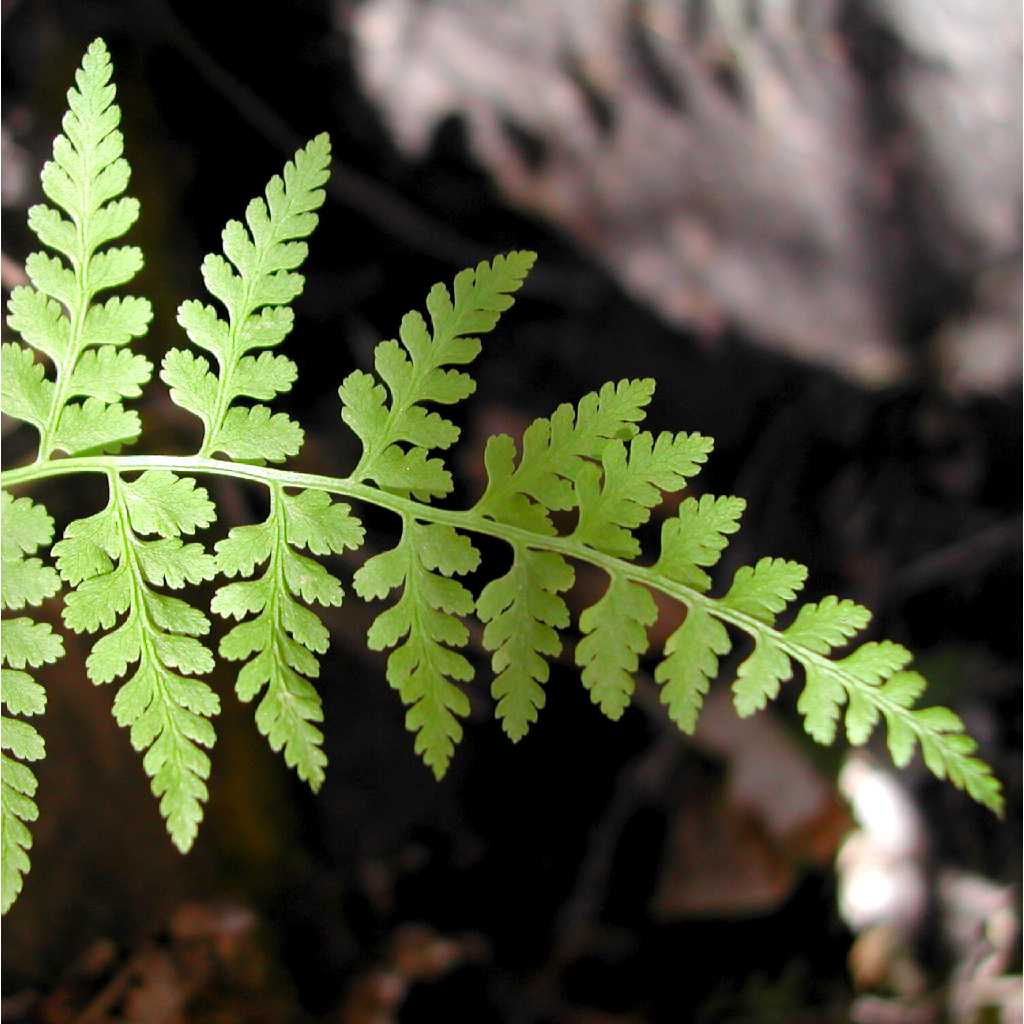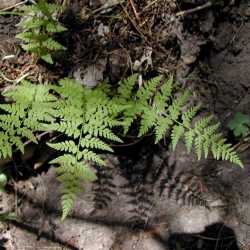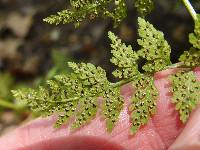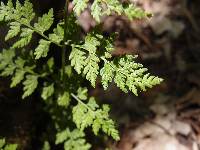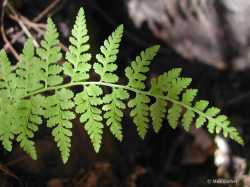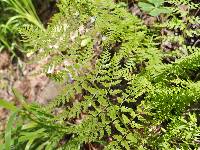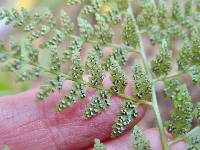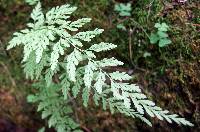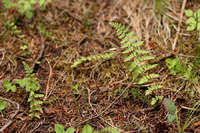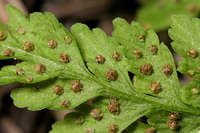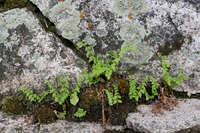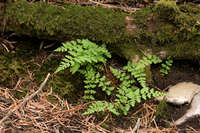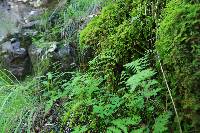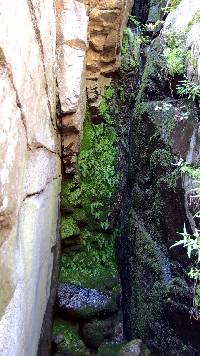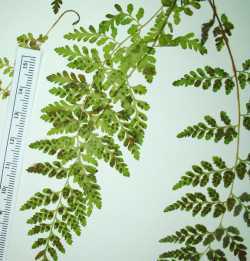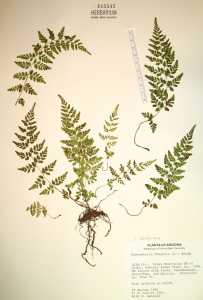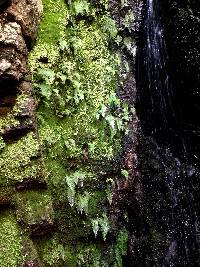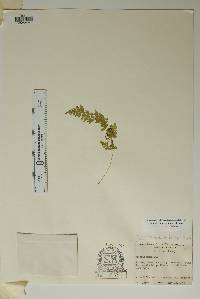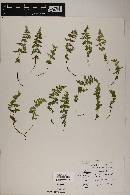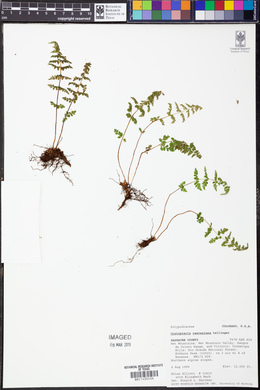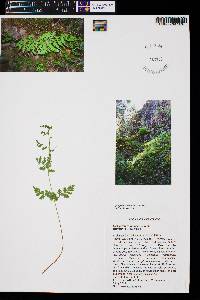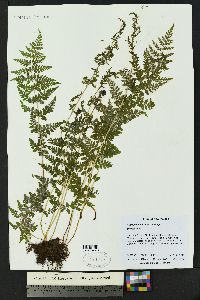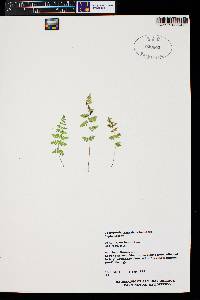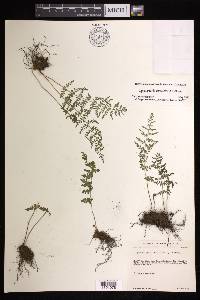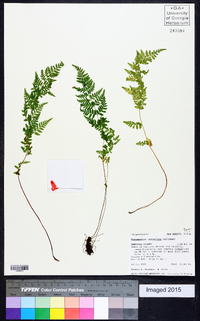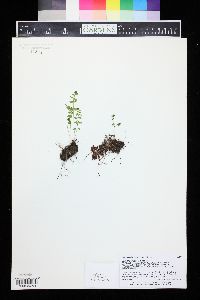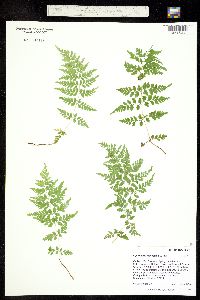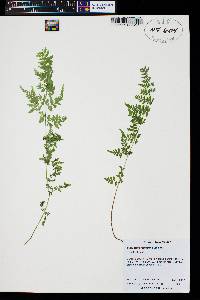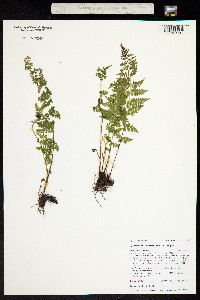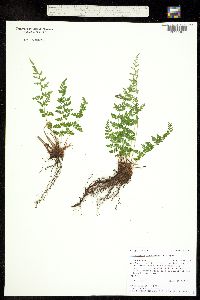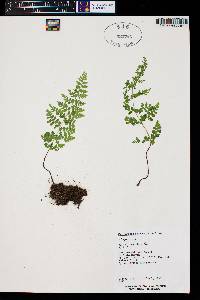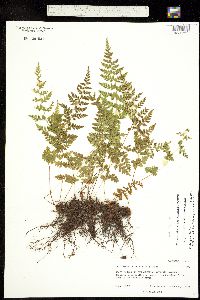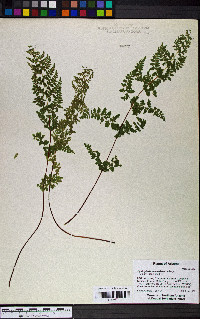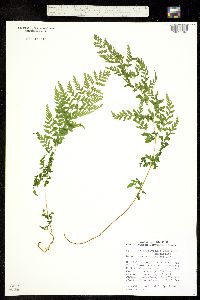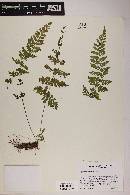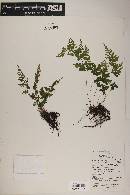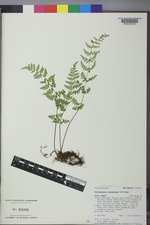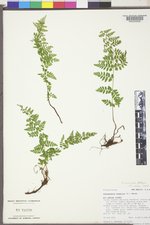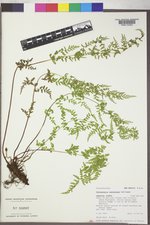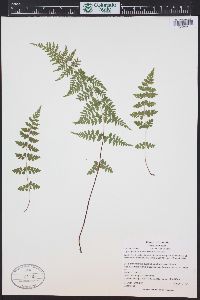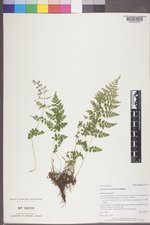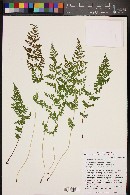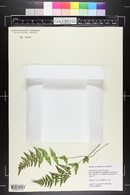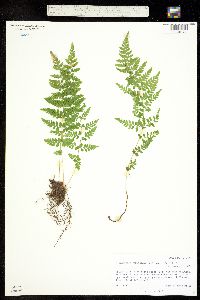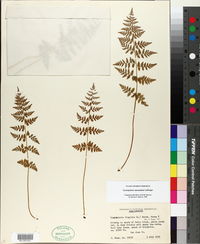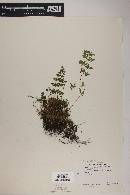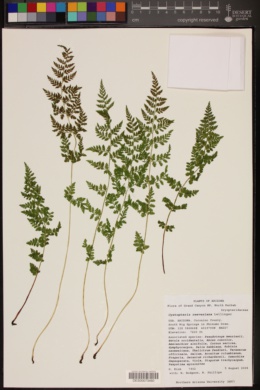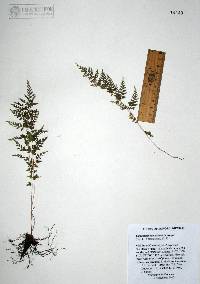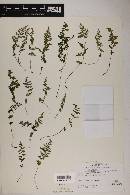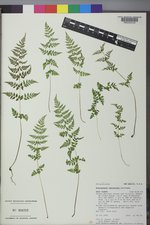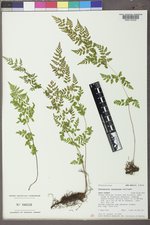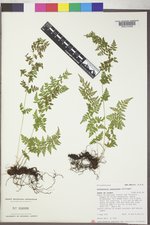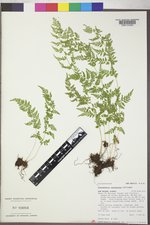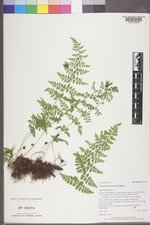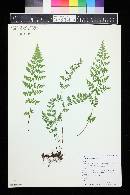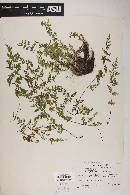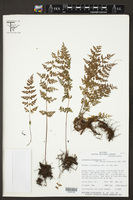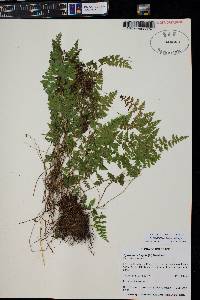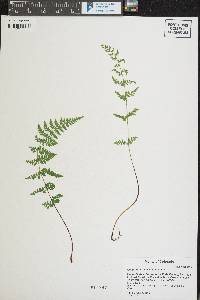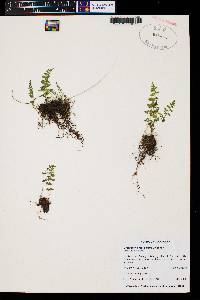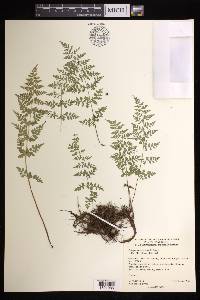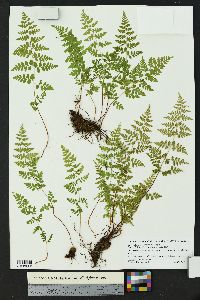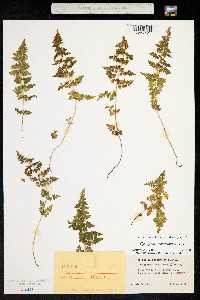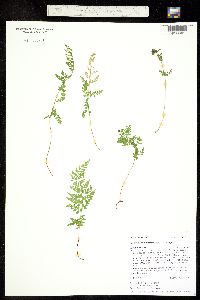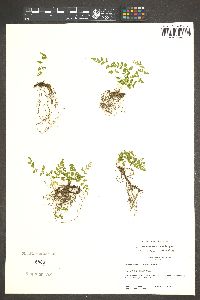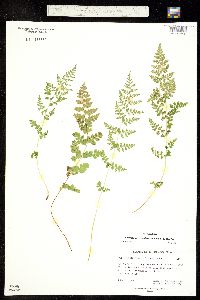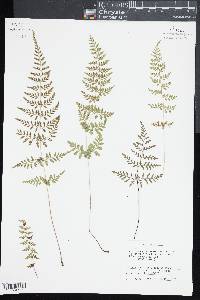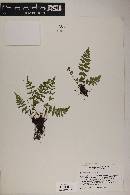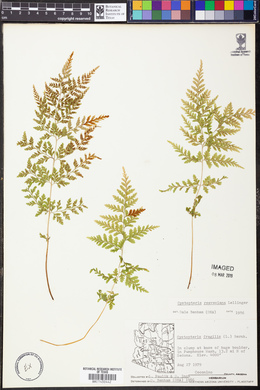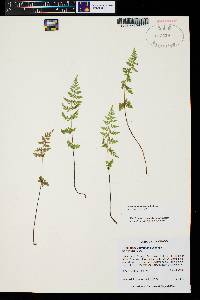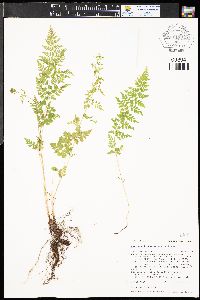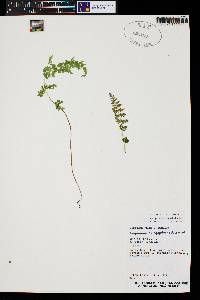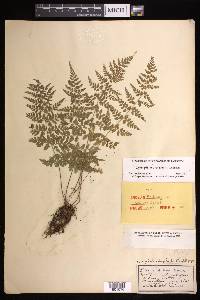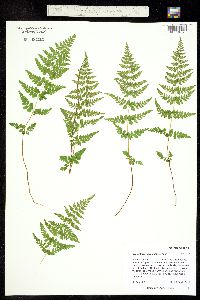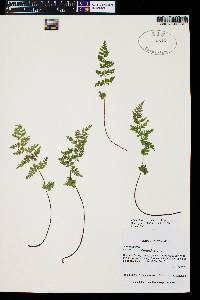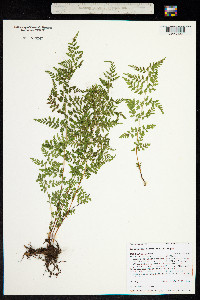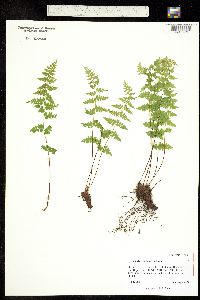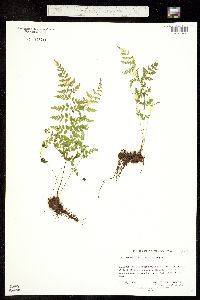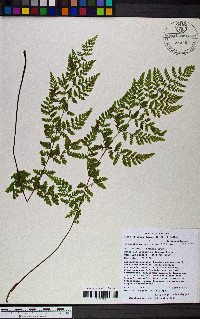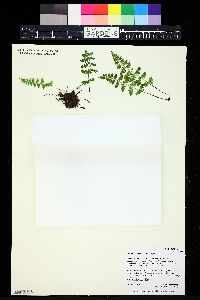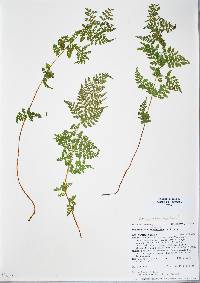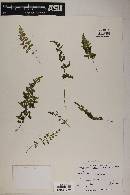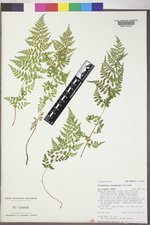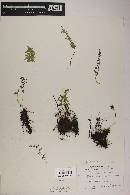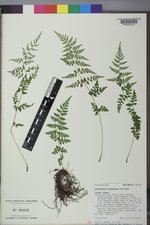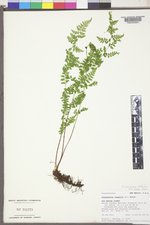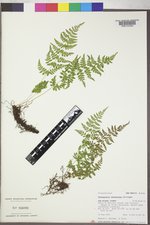
|
|
|
|
Family: Cystopteridaceae
Reeves' Bladder Fern, more...Reeves' bladderfern, Southwestern Brittle Fern
[Cystopteris fragilis var. tenuifolia (Clute) Broun] |
Stems creeping, not cordlike, internodes usually long, with scattered persistent petiole bases, hairs absent; scales tan to brown, ovate to lanceolate, radial walls thin, luminae tan. Leaves monomorphic, clustered at stem apex, to 45 cm, bearing sori throughout year. Petiole highly variable in color, from uniformly dark purple to uniformly straw-colored, but mostly dark purple at base, grading to straw-colored at junction with blade, shorter than blade, base sparsely scaly. Blade ovate to elliptic, 2--3-pinnate, widest at or just below middle, apex short-attenuate; rachis and costae lacking gland-tipped hairs or bulblets; axils of pinnae with occasional multicellular, gland-tipped hairs. Pinnae usually perpendicular to rachis, not curving toward blade apex, margins dentate to crenate; proximal pinnae pinnate-pinnatifid to 2-pinnate, ± equilateral, basiscopic pinnules not enlarged; basal basiscopic pinnules mostly short-stalked, base truncate to obtuse, distal pinnae deltate to ovate. Veins directed into teeth and notches. Indusia cup-shaped to lanceolate, gland-tipped hairs absent. Spores spiny, usually averaging 33--41 µm. 2 n = 84. Sporulating summer--fall. Terrestrial or on rock on variety of substrates; 1500--4000 m; Ariz., Colo., N.Mex., Tex., Utah; Mexico. The finely dissected leaves, dark petioles, creeping stems, smaller spores, and terrestrial habit distinguish Cystopteris reevesiana from C . fragilis in the southwest. On rock and at high elevations, however, C . reevesiana can have stems with short internodes and leaves that are reduced in size and dissection (resembling C . fragilis ). In southern Colorado, the two species are sympatric in some areas and form triploid hybrids. Cystopteris reevesiana and C . bulbifera are the diploid progenitors of C . utahensis , which occasionally crosses with C . reevesiana to produce sterile triploid hybrids of intermediate morphology.
General: Fronds clustered at stem apex, to 45 cm tall, petiole variable in color, dark purple to straw colored, dark purple at base, grading to straw-colored at junction with blade, shorter than blade, base sparsely scale; stems creeping. Leaves: Ovate to elliptic, 2-3 pinnate, widest at or just below middle, apex short-attenuate, lacking bulblets or gland tipped hairs; pinnae perpendicular to rachis, not curving toward apex, margins dentate to crenate; bottom pinnae pinnate to twice pinnate, equilateral; pinnules at base short-stalked, with truncate to obtuse base. Sporangia: Indusia cup-shaped to lanceolate, no gland tipped hairs; spores spiny. Ecology: Found on a variety of substrates, including rock from 5,000-12,500 ft (1524-3810 m); bearing sori year-round. Notes: Similar to C. fragilis, distinguished by the finely dissected leaves, dark petioles, creeping stems, smaller spores, and terrestrial habit. Etymology: Cystopteris from the Greek cystis for bladder and pteris fern, referring to the indusium, while reevesiana is named for Robert Gatlin Reeves (1898--), an American botanist who studied corn and other grasses. Sources: FNA 1993, Lellinger 1981, Dittmer 1954, Yarborough and Powell 2002 FNA 1993, Lellinger 1981, Dittmer 1954, Yarborough and Powell 2002 Common Name: Reeves' bladderfern Rarity: None General: Fronds clustered at stem apex, to 45 cm tall, petiole variable in color, dark purple to straw colored, dark purple at base, grading to straw-colored at junction with blade, shorter than blade, base sparsely scale; stems creeping. Leaves: Ovate to elliptic, 2-3 pinnate, widest at or just below middle, apex short-attenuate, lacking bulblets or gland tipped hairs; pinnae perpendicular to rachis, not curving toward apex, margins dentate to crenate; bottom pinnae pinnate to twice pinnate, equilateral; pinnules at base short-stalked, with truncate to obtuse base. Sporangia: Indusia cup-shaped to lanceolate, no gland tipped hairs; spores spiny. Ecology: Found on a variety of substrates, including rock from 5,000-12,500 ft (1524-3810 m); bearing sori year-round. Notes: Similar to C. fragilis, distinguished by the finely dissected leaves, dark petioles, creeping stems, smaller spores, and terrestrial habit. Ethnobotany: Unknown Etymology: Cystopteris from the Greek cystis for bladder and pteris fern, referring to the indusium, while reevesiana is named for Robert Gatlin Reeves (1898--), an American botanist who studied corn and other grasses. Synonyms: Cystopteris fragilis var. tenuifolia Editor: SBuckley, 2010 |
|
|
|
This project was made possible in part by the Institute of Museum and Library Services [MG-70-19-0057-19].
Powered by Symbiota

